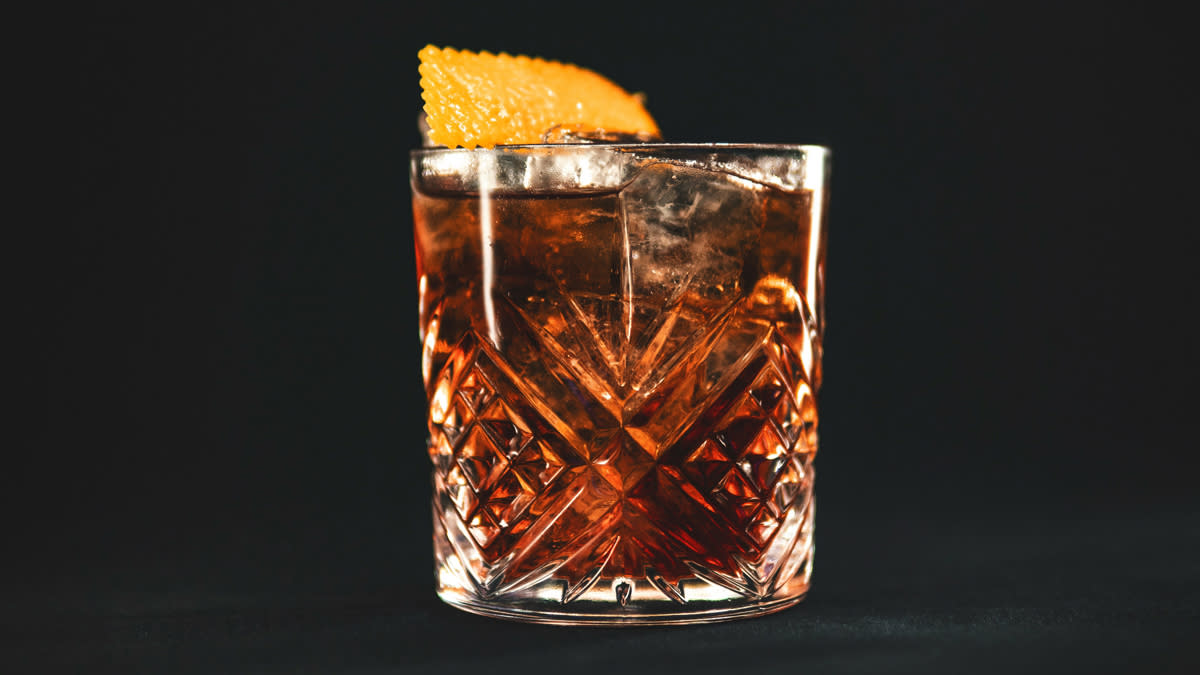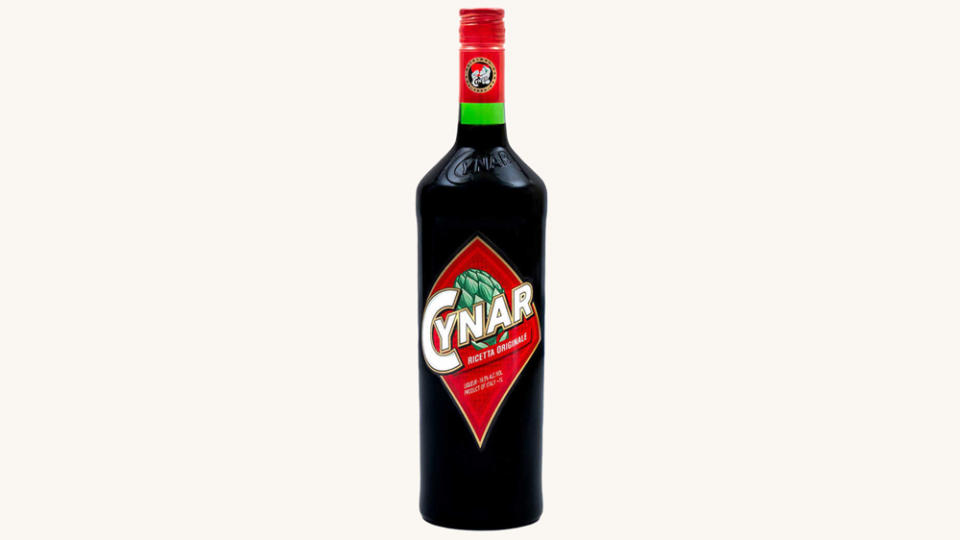How to Make a Bitter Giuseppe, the Rule-Breaking Cocktail That Favors Flavor Over Booze

The Bitter Giuseppe is a strange and wonderful drink. The components feel like they’re put in backwards and upside down, and looking at the recipe, you’d think they were chosen at random. It is not just a new drink but a new category of drink, an undiscovered landmass in what felt like well-mapped territory; the Bitter Giuseppe is what a bartender might think up if, after asking an indecisive guest if they’d prefer something shaken and refreshing, or stirred and spirituous, the guest replied, “both, but also neither.”
“Sometimes a cocktail tells you what to do, rather than you telling it what to do,” recounts Stephen Cole in The Bartender’s Manifesto, the 2022 book about Chicago’s celebrated speakeasy, the Violet Hour. In or around 2007, an Italian chef had come into the Violet Hour and asked Cole for a drink. In a flash of inspiration he can’t explain, he decided to use as a base of the drink not whiskey or gin or brandy but Cynar, a robustly bitter, low alcohol Italian liqueur. This in and of itself, at the time, was fairly insane. To this he added an ounce of sweet vermouth, making a kind of bitter, low-ABV Manhattan.
More from Robb Report
How to Make a Fort Point, Boston's Incredible Answer to the Manhattan
How to Make a Booze-Free Piña Colada, the Best Cocktail for Dry January and Beyond
How to Make a Kir Royale, a Bright Champagne Cocktail With a Blackcurrant Twist
It was delicious, but it was too sweet. The standard corrective would be to add whiskey, but that would just make it more conventionally Manhattan-like, so he took a risk and added a very small amount of lemon juice. Then a little more, then a little more. “I just kept tasting and trying to correct my fuckups to the point where it would take a full quarter ounce of lemon and an aggressive six dashes of orange bitters for it all to come together,” he says.
Before this, no one would ever add lemon to a drink like this. Lemon juice was for sour-style drinks, like the Whiskey Smash or Tom Collins. Stirred, all booze cocktails pretty much never had lemon juice in them; it was practically a law. But Cole had recently been enjoying the sole exception to this—the lovely ‘Ti Punch, from Martinique, essentially a rum Old Fashioned with a squeeze of lime instead of bitters—and wondered if that could work here. “I was blindly moving around trying to make it work,” he writes, “and ended up just knocking it out of the park.”
Out of the park indeed. The Bitter Giuseppe is the father of pretty much all Cynar-based cocktails in general (and the Growing Old… specifically), and though it was invented just 15 years ago and doesn’t show up in many books, every cocktail bartender I know can make one from memory. As a low-alcohol drink and/or aperitivo it’s absolutely phenomenal, perfect for before a meal, for “Damp January,” or any other time you want to stay light on booze but heavy on flavor. The Cynar is deeply resonant with caramel and vegetal hum, while the vermouth offers bright and fruity top notes, the lemon juice keeps the experiment surprisingly light and fleet of foot, and the salt (see note, below recipe) reduces the bitterness and makes the whole thing pop. That the recipe reads like the product of a dare is immaterial. Try one out and see.
Bitter Giuseppe
2 oz. Cynar
1 oz. sweet vermouth
0.25 oz. lemon juice
6 dashes of orange bitters (optional)
Pinch of salt (optional)
Stir all ingredients on ice and pour over fresh ice into a rocks glass. Garnish with a lemon peel.
NOTES ON INGREDIENTS

Cynar: Cynar (pronounced “chee-nar”) is a 16.5 percent alcohol bitter liqueur from Italy. This drink needs it or something just like it, and you can’t just grab a different amaro and hope it’ll work. Note that Cynar also makes a “70,” a version that’s 35 percent alcohol, which is not what we want here. We want the standard, red bottle.
The only other thing to say about this is that Cynar is the biggest and most famous of what some people call the “carciofi,” which is to say, Amaros (Italian-style bitter liqueurs) flavored with, among other things, artichokes. N.B. that Cynar does not taste like artichokes—there is a vegetal quality to be sure, but mostly the experience is a caramely roundness, citrus, and robust earthy bitterness. Also, in all my years of running cocktail bars, I’ve only been exposed to a single other example of a carciofo amaro and, suffice to say, it didn’t make a better Bitter Giuseppe. Feel free to try with others if you find them, but know this drink was created for Cynar.
Sweet Vermouth: Cole originally made this for Carpano Antica, a robust and powerful sweet vermouth. This is a great choice and makes a delicious Bitter Giuseppe, very round, with the vermouth’s distinct vanilla presence playing a large role. This is also great with the leaner end of the spectrum, something like Dolin Rouge, with which the Bitter Giuseppe is a lot lighter and brighter, more aperitivo-like, better for before a meal. Still others make it with Punt e Mes, a deep chocolaty vermouth that has a significant amount of bitterness itself, which makes a fuller, more convincingly cocktail-like finished product. These are all equally delicious to me, as would be others. Choose the intensity that works for you.
Orange Bitters: From The Bartender’s Manifesto: “six dashes is a lot, but the large amount of bitters will add both proof and complexity, which is much needed in this situation.” It’s not like I don’t see what he’s getting at—orange bitters in that quantity add a stong zesty, almost juicy orange presence, amplifying the vermouth’s top notes and balancing the low hum of the Cynar. That said, for my palate, I don’t prefer them. I think it’s good without. Feel free to find your own way.
Salt: First, the why: Salt, as it turns out, mitigates bitterness even more than sugar does, and in this case allows the tertiary flavors of Cynar to shine out from where they would ordinarily be bludgeoned by bitterness. Salt makes the drink pop.
As for the how: Cole’s original doesn’t have salt, and salt is omitted from most official recipes. That said, most of the bartenders I know (including me) had it in our heads that salt was called for. A bit of digging finds that Kirk Estopinal (of New Orleans’ Cane & Table) made a riff on the Bitter Giuseppe he called the Search for Delicious, roughly the same drink but with Punt e Mes instead of Carpano Antica, a bunch of lemon peels and a dash of salt, and the recipes just kind of melded in people’s brains. That puts the above recipe I suppose halfway between the Search for Delicious and the Bitter Giuseppe, but in either case, I think salt adds to it well. I recommend a pinch.
Best of Robb Report
Why a Heritage Turkey Is the Best Thanksgiving Bird—and How to Get One
The 10 Best Wines to Pair With Steak, From Cabernet to Malbec
Sign up for Robb Report's Newsletter. For the latest news, follow us on Facebook, Twitter, and Instagram.


